Aikin Lambert Combination Retracting Pen Holder and Pencil c. 1880-90s
by Jim Mamoulides, June 4, 2017, updated September 27, 2024
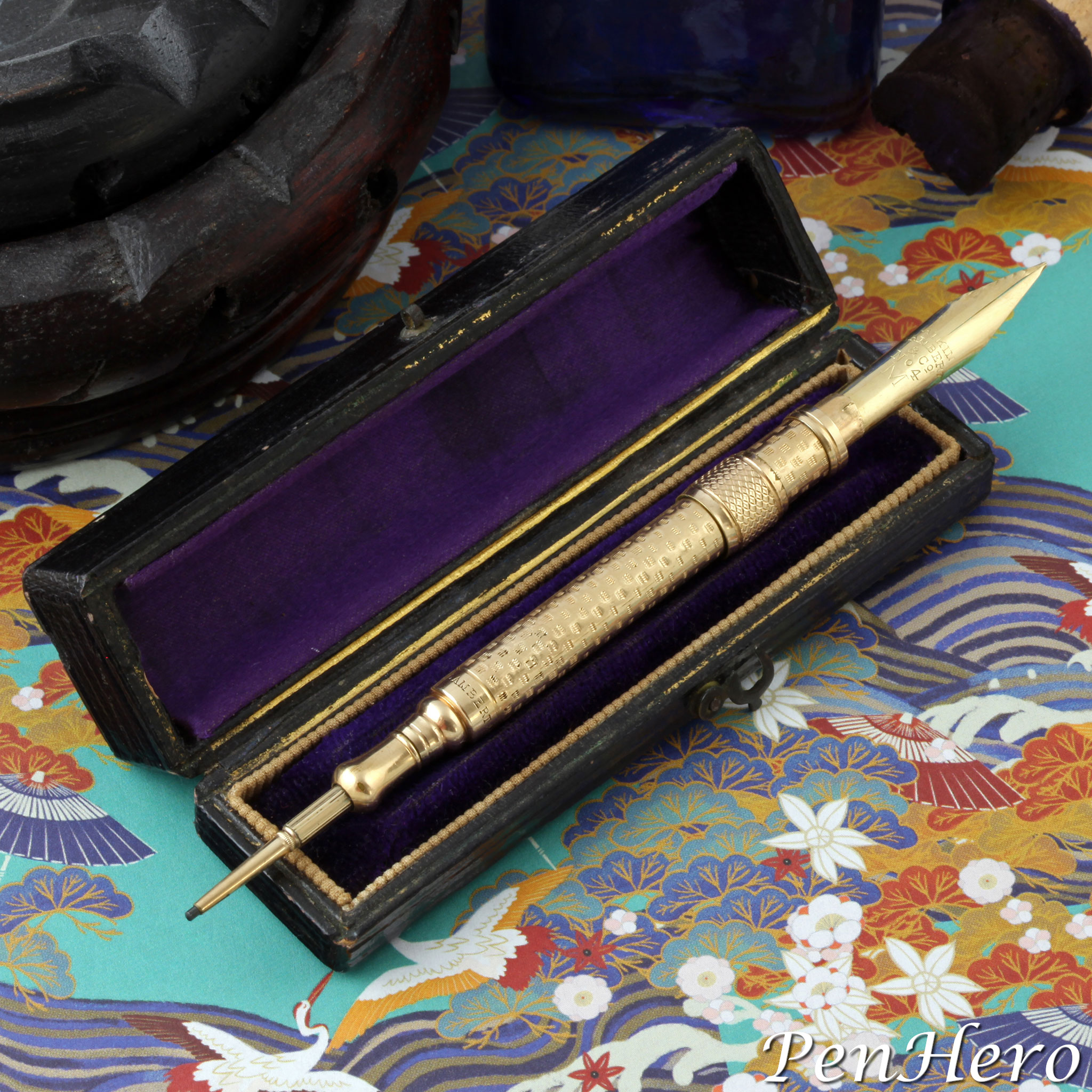 Aikin Lambert combination retracting pen holder and pencil c. 1880-90s
Aikin Lambert combination retracting pen holder and pencil c. 1880-90s
A Tiny Beauty
A very interesting find made in a New Bern, North Carolina antique store several years ago. This is an Aikin Lambert combination retracting dip pen holder and retracting twist mechanical pencil c. 1880-90s, complete with the original box. Fully open, as shown, the instrument is 4 7/8 inches long. Closed, it's a tiny 2 11/16 inches long. The nib extends by pushing the knurled band on the barrel from the pencil end toward the open end where the nib is hidden. The nib slips onto a tab that holds it in place and is kept inside the barrel when not in use. The very flexible gold nib is stamped AIKIN over LAMBERT over & CO over No 4 over M, a medium flexible nib. The mechanical pencil extends by pulling it out from the barrel and the lead advances and retracts by twisting the knob near the tip where the lead comes out. A beautiful and complex tiny writing instrument that is as much jewelry as it is functional.
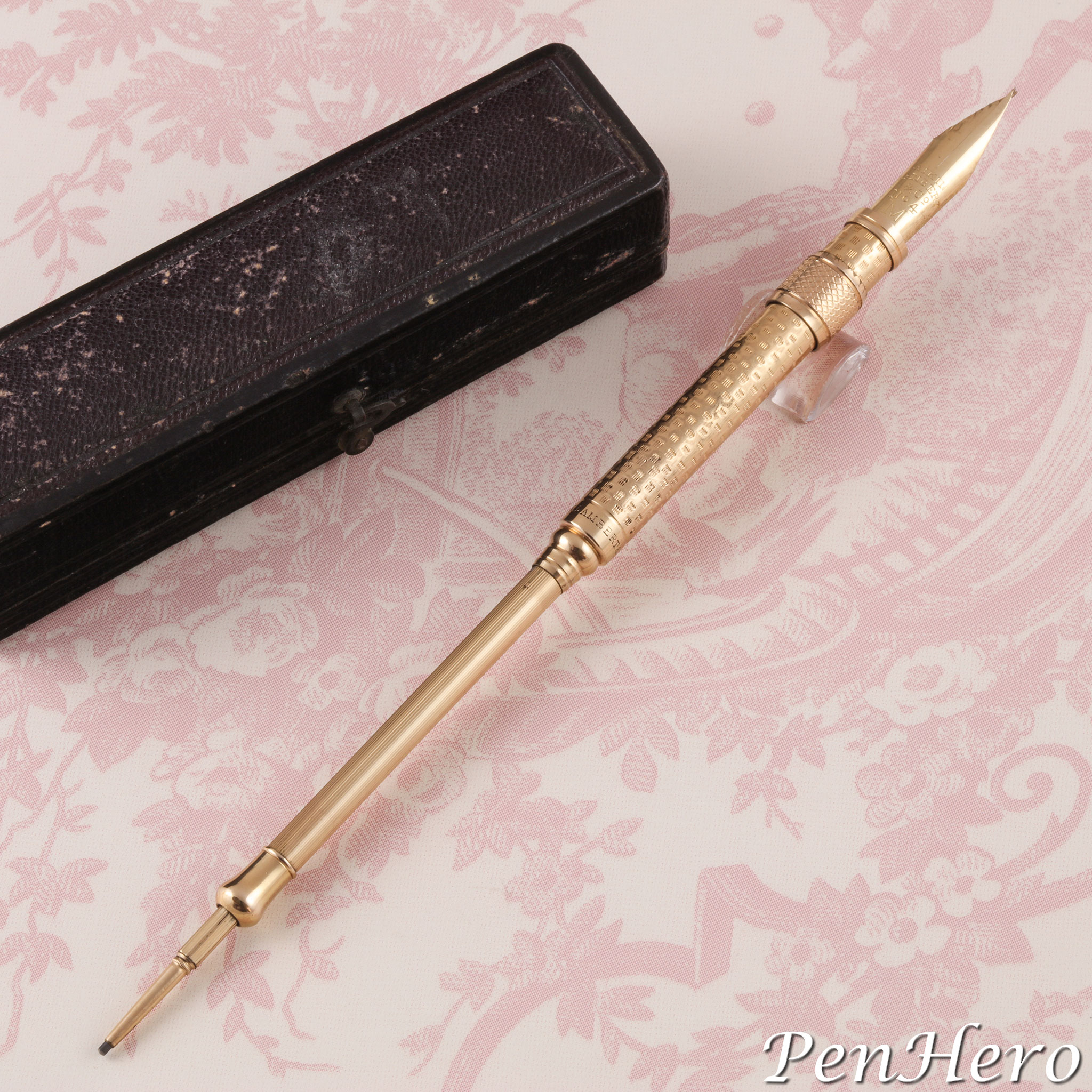 Aikin Lambert combination retracting pen holder and pencil c. 1880-90s
Aikin Lambert combination retracting pen holder and pencil c. 1880-90s
The barrel is decorated with an engraved checkerboard pattern where each square consists of four short hash lines. The band is engraved with a knurled pattern and the pencil extension tube has a tight linear engraved pattern. The pencil end of the barrel is stamped AIKIN LAMBERT & CO 3. There are no hallmarks and very little plating wear, so I believe the instrument is gold filled. There is unfortunately very little catalog or advertisement information available that identifies specific Aikin Lambert models, engraving patterns, and prices so I am unable to provide that information or specific dating.
Aikin, Lambert & Co.
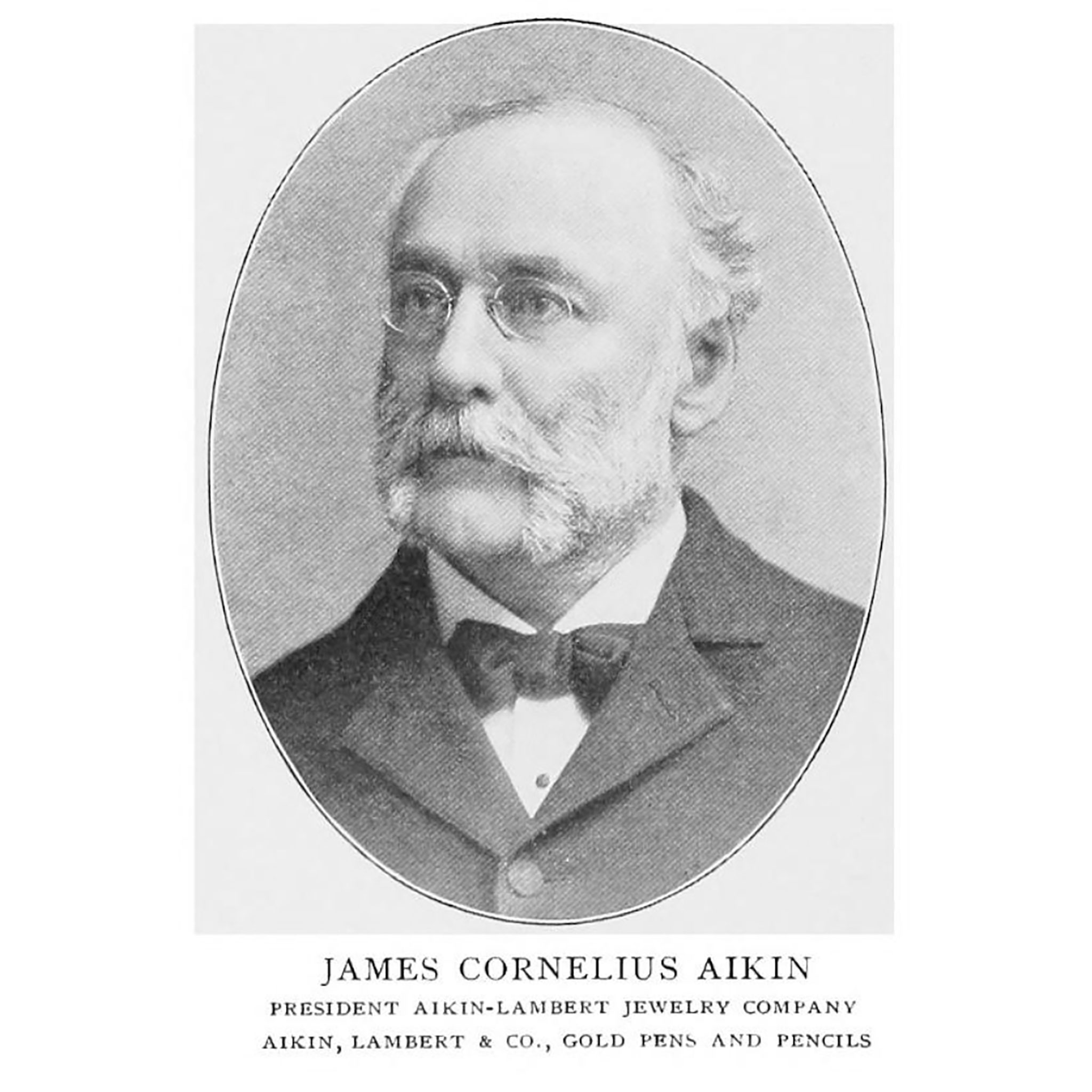 Portrait of James C. Aikin from Kings Notable New Yorkers, Pens and Jewelry, 1899
Portrait of James C. Aikin from Kings Notable New Yorkers, Pens and Jewelry, 1899
James Cornelius Aikin was born on July 13, 1840, the son of Joseph and Mary Aikin, in a rural farming community in Dutchess County, New York, near Poughkeepsie. He was sent to boarding school upstate in Rochester, New York and after graduation, moved to New York City in 1859. One of his first jobs was at the Morton Pen Company, probably working in a clerical position. Upon the outbreak of the Civil War, he enlisted in the 7th Regiment of the New York National Guard, a unit that was organized in 1806 in response to British aggression against United States shipping and is still in existence today. After serving briefly in the defense of Washington, D.C., he returned to New York City.
There are some conflicts about the dates of Aikin’s return to New York City and the establishment of his first partnership in the pen and jewelry business with Edward D. Valentine. Two accounts, in 1919 obituaries for Henry A. Lambert, Aikin’s longtime business partner, state that Aikin was in a partnership not only with Valentine but also a Mr. McConnell in 1861. McConnell, Valentine & Aikin, had a very short life when Valentine and McConnell withdrew from the partnership the same year. Aikin then formed a new company, J. C. Aikin & Co. at "16 Maiden Lane" in lower Manhattan, with Lambert as a partner.
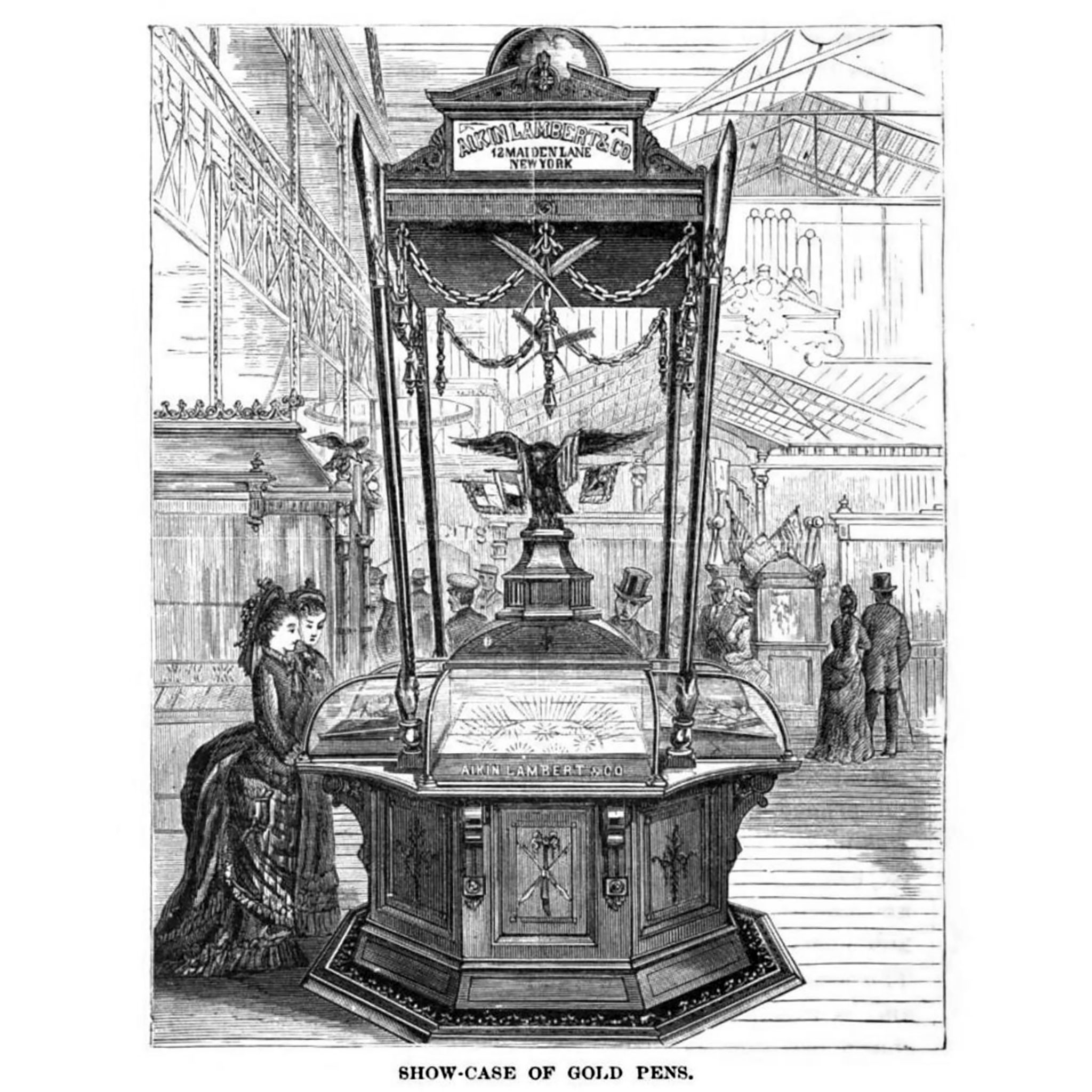 Aikin, Lambert & Co. display case at the Centennial International Exhibition of 1876 held in Philadelphia, Pennsylvania, from May 10 to November 10, 1876
Aikin, Lambert & Co. display case at the Centennial International Exhibition of 1876 held in Philadelphia, Pennsylvania, from May 10 to November 10, 1876
I think the 16 Maiden Lane address is possibly a typo or timing issue. The earliest address I could find for J. C. Aikin & Co. appears in a Help Wanted advertisement in the October 23, 1864 New York Daily Herald seeking a "man to take charge of a gold pen manufactury; also a grinder" with the address listed as 14 Maiden Lane. This also shows the company intended to or was making gold nibs from the very beginning. Another help wanted advertisement in 1866 shows the same address. By 1871 the company had either expanded into 16 Maiden Lane or were already there and now using that address as primary. They also opened a sales office in Chicago at 88 West Washington Street. By 1874, the Chicago office had moved around the corner to 34 Dearborn Street. The company must have moved around or added close and adjacent locations on Maiden Lane in New York City in the early days as I found addresses of 12 Maiden Lane in 1875 and 1876, and 23 Maiden Lane from 1878 to 1885. By mid 1891, the company moved to or acquired additional space at 19 Maiden Lane, using that address in advertisements by August of that year. In 1908 the address is 15 Maiden Lane, either a move or acquisition of even more space.
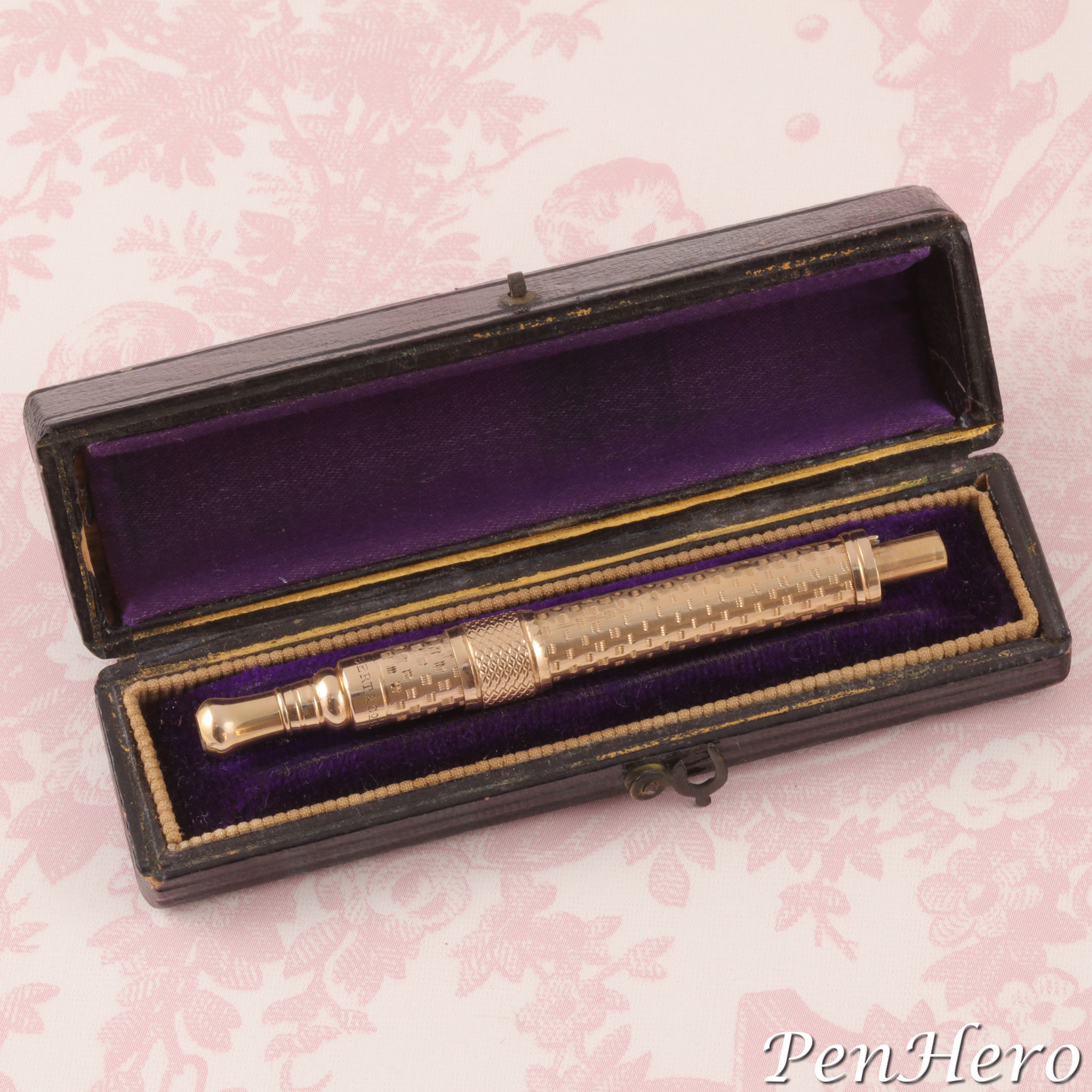 Aikin Lambert combination retracting pen holder and pencil c. 1880-90s
Aikin Lambert combination retracting pen holder and pencil c. 1880-90s
A biography of Aikin in the 1910 National Cyclopedia differs, saying Aikin returned to New York City in 1862, entered into a partnership with Valentine that same year to make gold pens (nibs) and jewelry, with the business located at 148 William Street in lower Manhattan. That biography says he left that business to establish his own jewelry company, J. C. Aikin & Co. in 1864. An interesting confirmation of the 1864 date is shown on the 1918 Aikin Lambert Guarantee, which says the company was established in 1864. I would guess that Lambert’s obituary, likely written by his family, may have some facts incorrect. I believe that Aiken’s 1910 account, done about a year before his death, more likely has the correct dates.
Henry A. Lambert, Aikin’s longtime partner and the Lambert of Aikin Lambert, was born in Woodbury, Connecticut on August 7, 1837 and spent his early twenties in a small stationery and “drug business” in Wisconsin. If his obituary is correct, he had moved to New York City by 1861, then joining Aikin as a business partner, though it may have been later, in 1864. Lambert was known as a “traveler,” likely a description for a traveling salesman, and continued in that role after Aikin, Lambert & Co. was sold to L. E. Waterman Co. He died of bronchial pneumonia on May 9, 1919 while on a business trip in Asheville, North Carolina. He was known as the “oldest jewelry traveler” at the time of his death at the age of 81.
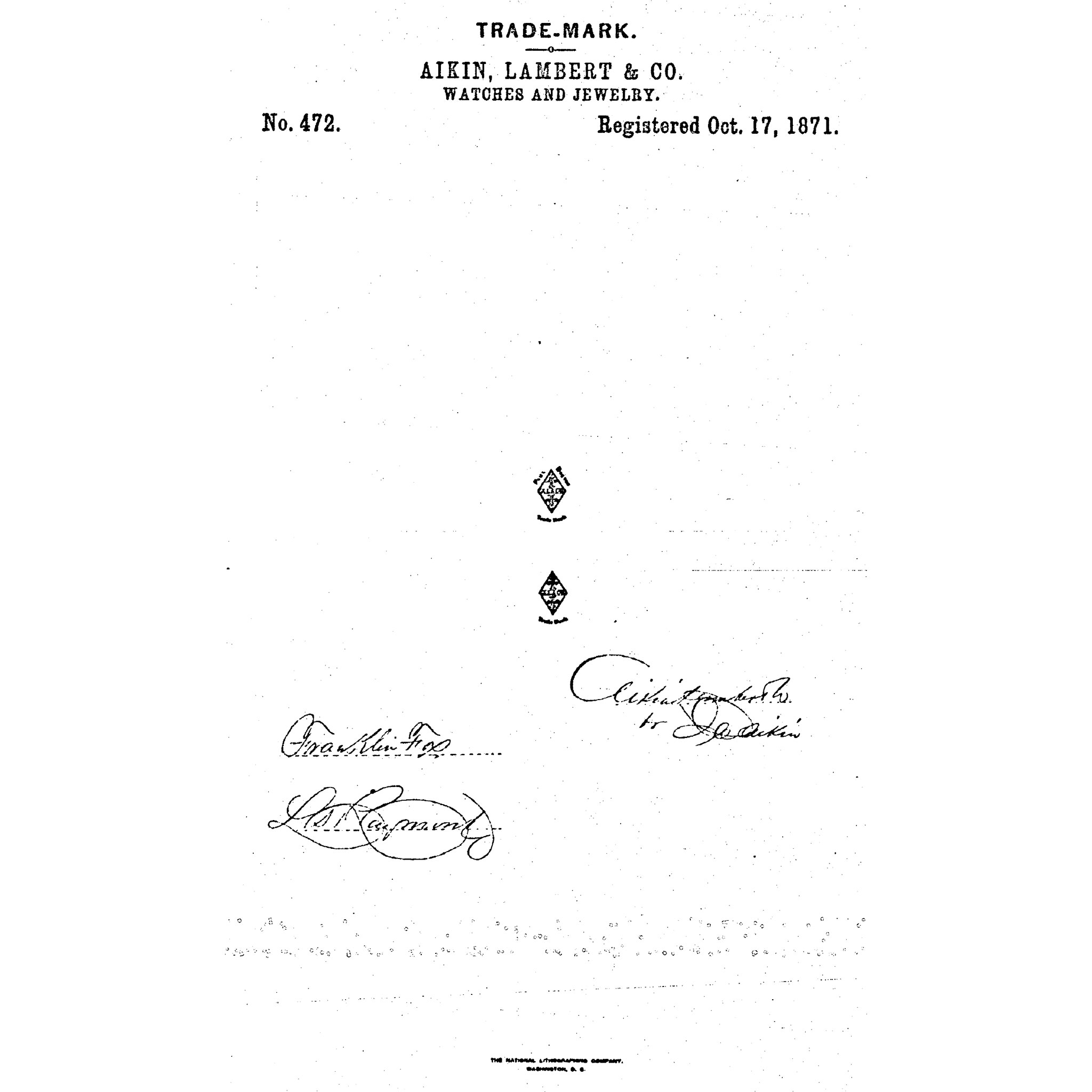 Aikin, Lambert & Co. trademark, October 17, 1871
Aikin, Lambert & Co. trademark, October 17, 1871
The earliest trademark I could find for Aikin, Lambert & Co. was registered October 17, 1871 for a four sided elongated diamond shaped “lozenge” with “the initials of the firm name ‘A. L. & Co.’ in the center between two fleurs de lis placed above and below in the longest ends.” The intent was to use the logo on business documents and as a mark on watch cases and other goods. The trademark document reveals that the company was selling “Paul Breton” Swiss watches at the time, which may have been imported and sold under this name as the company’s own brand. The trademark document lists Aikin, Lambert, and John B. Shea as partners in the company at that time.
Aikin was president of the company from the beginning and for his entire tenure. Lambert was treasurer and “traveler” from the beginning of his time with the company. Shea joined in 1867 as a gold pen maker and became vice president at least as early as 1877, based on advertisements I uncovered. Shea also eventually became superintendent of the factory as noted in the July 14, 1906 American Stationer. James C. Wakefield joined as early as 1894 and became the company secretary.
Works Like Magic
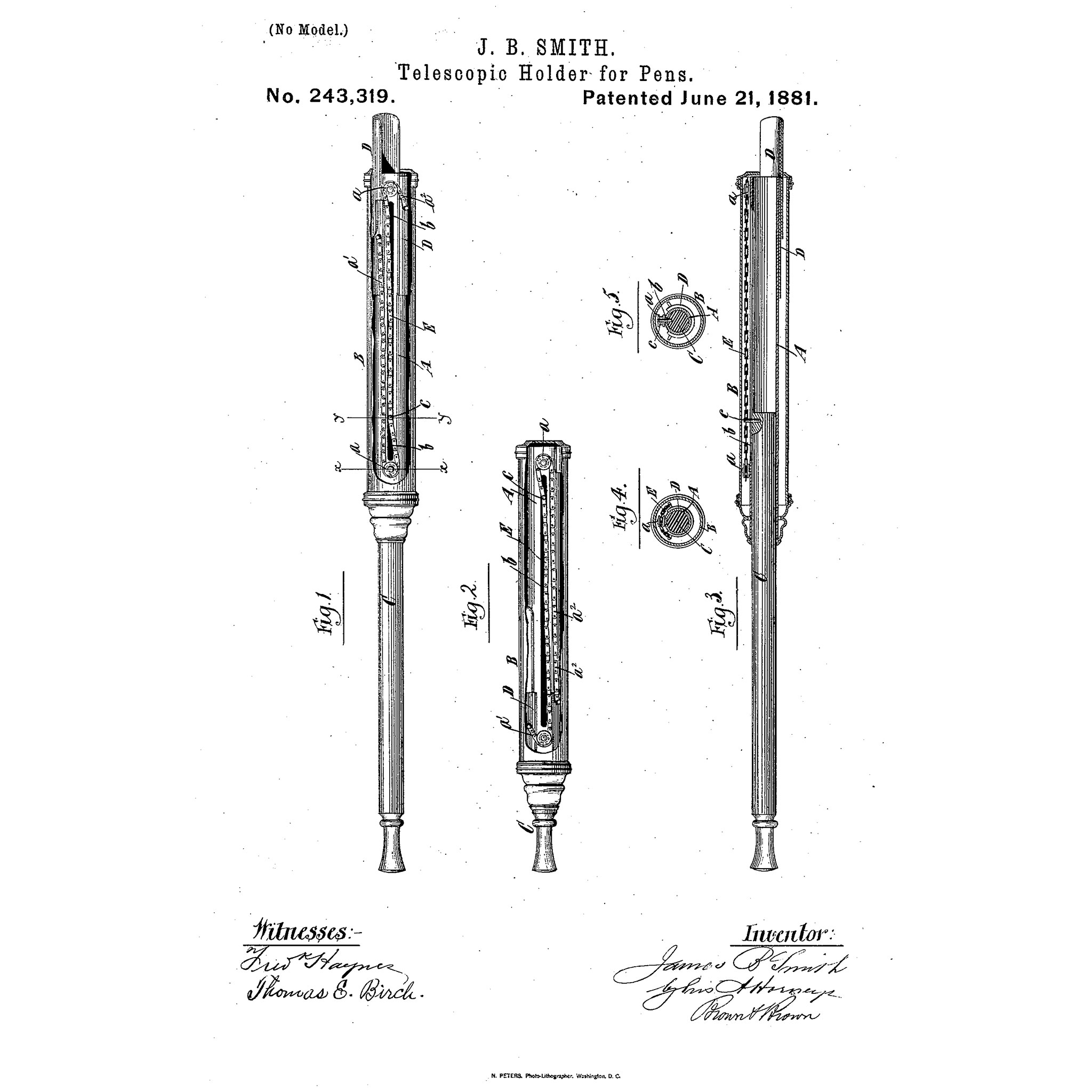 United States Patent 243,319, June 21, 1881
United States Patent 243,319, June 21, 1881
The company was active in patenting designs, inventions, and trademarks. I was able to find twelve total between 1871 and 1915, with the last one awarded after the sale to Waterman. A patent for a telescopic pen holder was awarded to J. B. Smith and assigned to Aikin, Lambert & Co., as United States Patent 243,319 on June 21, 1881. The patent was applied for on March 17, 1881, meaning the company was looking at making compact telescoping pen holders as early as that year. The design is very complex, composed of an inner and outer metal barrel with a sliding rod working with the inner barrel, attached to a chain that extends the nib when the slide is pulled out. I’ve never seen one but they were manufactured.
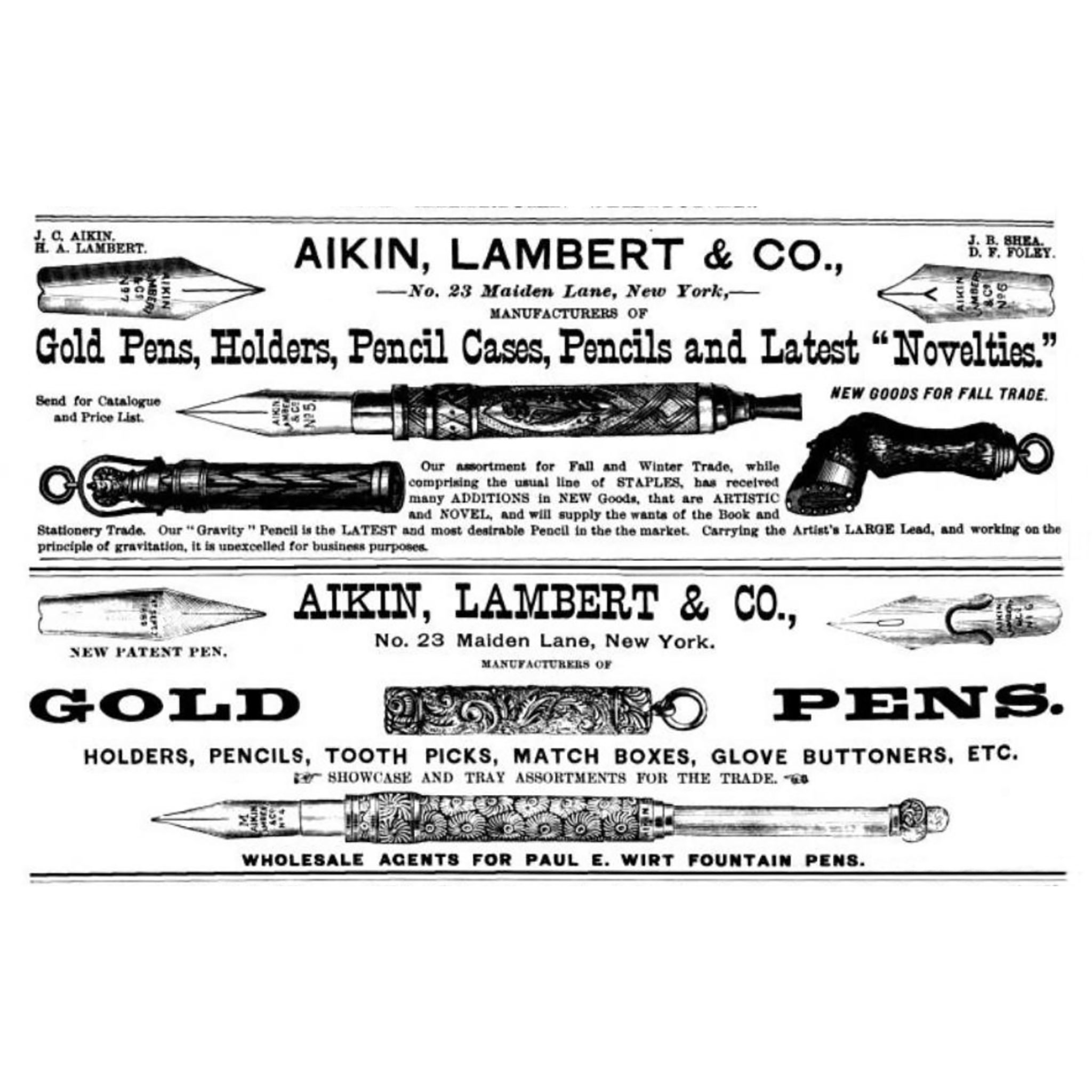 Advertisements in the American Stationer, top from 1883, bottom from 1891
Advertisements in the American Stationer, top from 1883, bottom from 1891
The operation of the pen holder shown in this article is very simple. It has a movable band that surrounds the barrel and attaches directly to an internal slide that the nib tab slips securely into. The band has a tab that attaches to the slide through a long slot in the barrel. Moving the band moves the nib in and out of the barrel in the same direction it is pushed. The earliest example I've seen of an Aikin Lambert pen holder with a similar operating design to the one shown here is in the July 5, 1883 American Stationer. Closed, that pen holder would also be very compact. The end opposite the nib would pull out to give length for writing comfort, like a dip pen taper, and it has a movable band and slide operation similar to the combination instrument shown in this article. In the advertisement, it’s shown pushed fully forward, putting the nib in writing position. A similar design is shown in advertisements as late as 1891.
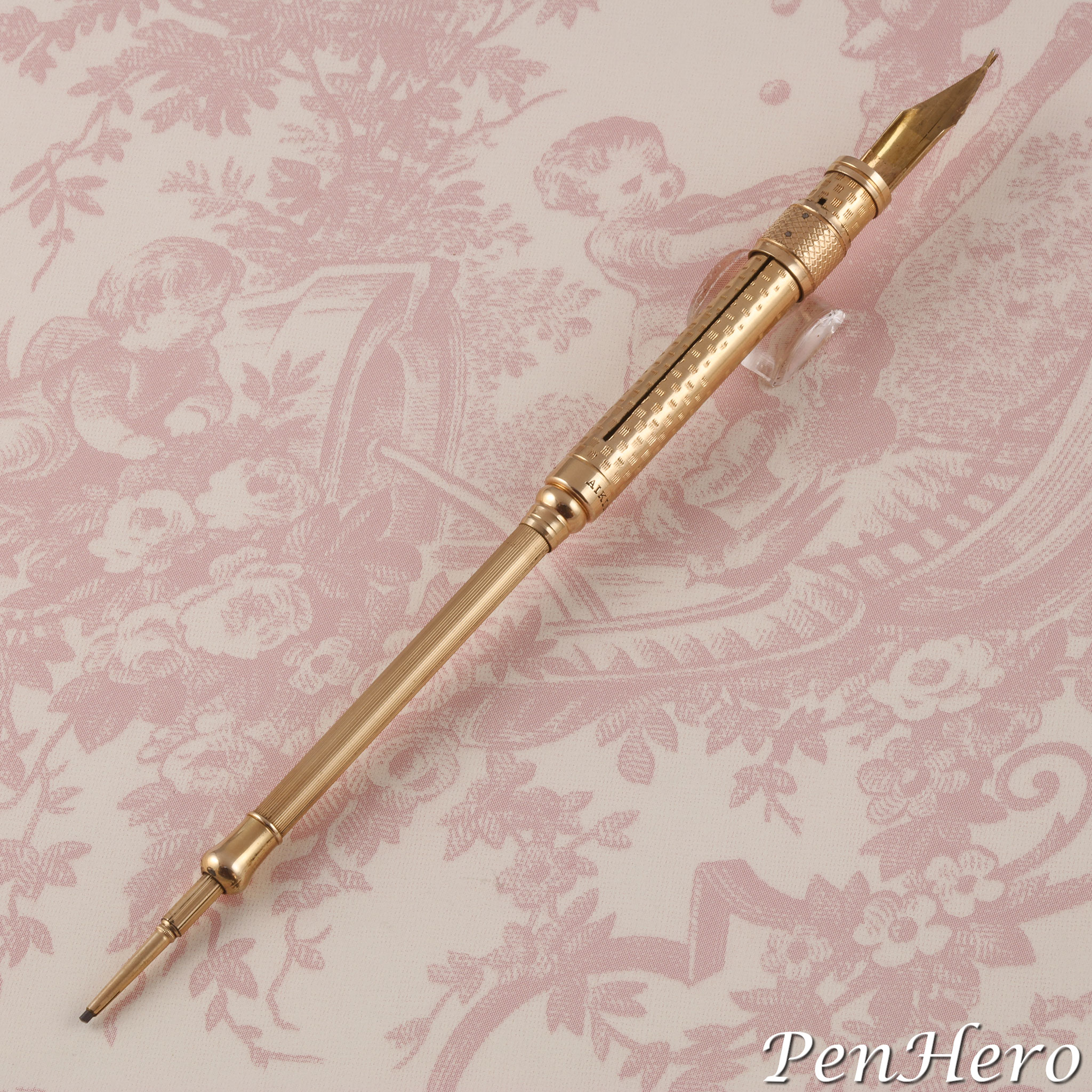 Aikin Lambert combination retracting pen holder and pencil c. 1880-90s, with pen and pencil fully extended and turned to show the slot in the barrel
Aikin Lambert combination retracting pen holder and pencil c. 1880-90s, with pen and pencil fully extended and turned to show the slot in the barrel
I've noticed in all the examples and illustrations I've seen the band and the barrel are engraved with different but complimenting highly detailed engraving patterns. I have not been able to find an advertisement or catalog that shows a combination instrument like the one in this article but I have seen others with different engraving patterns. Since Aikin Lambert was also making compact mechanical pencils at the same time, I would guess that the combination type followed at some point, making a date from the mid 1880s to the 1890s likely.
All This and Fountain Pens, Too!
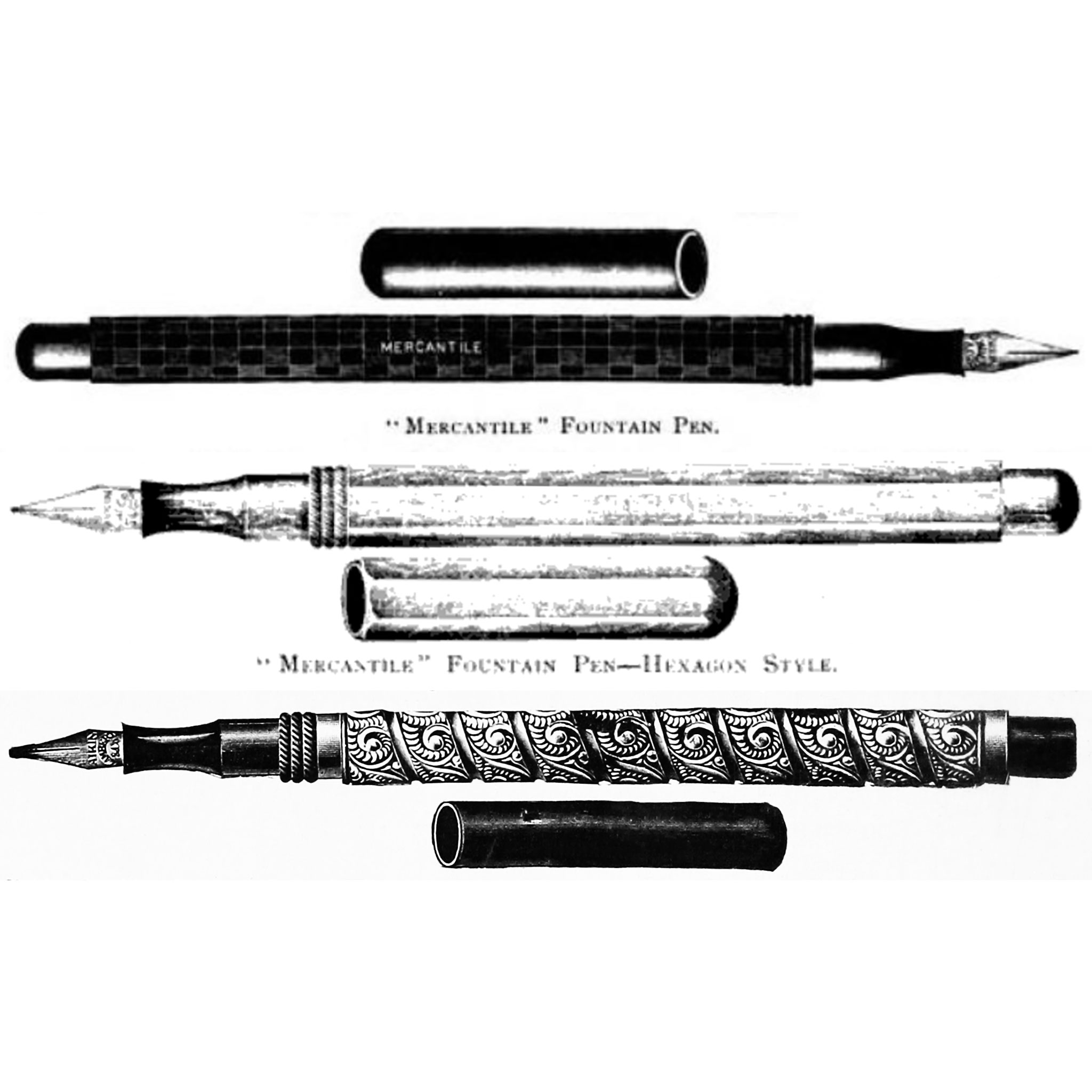 Aikin, Lambert & Co. Mercantile Fountain Pen illustrations: top from June 28, 1894, middle from September 20, 1894, bottom from March 12, 1895
Aikin, Lambert & Co. Mercantile Fountain Pen illustrations: top from June 28, 1894, middle from September 20, 1894, bottom from March 12, 1895
Aikin Lambert made a large number and variety of pen holders, pencil cases, retracting pencils, and combination pen holders and pencils, including purely novelty items. Aikin Lambert sold Paul Wirt fountain pens in the 1880s and began making their own eyedropper fountain pens at some point in the 1890s. The earliest company advertisement I could find for a fountain pen is for the Mercantile Fountain Pen in the June 28, 1894 American Stationer, which turned out quite successful. The first pens were conventional cylindrical hard rubber pens. By September 1894, a hexagonal pen was introduced and the company reported sales of more than 30,000 units. Holders with gold, silver and pearl mountings were also introduced. A short blurb in the December 5, 1894 Jeweler’s Circular says the pen “has met with such great success that the firm are having difficulty in filling all the orders on time.”
The company always had two primary businesses, one making pens, pencils and associated holders, and the other wholesaling watches, jewelry and diamonds. This shows in advertisements as early as 1892. I don’t have an exact fix on the date of sale of Aikin, Lambert & Co. to Waterman, but significant reorganizations occurred in 1906, separating the pen company's leadership from the jewelry company, with Aikin as president of both, as reported in the July 14, 1906 American Stationer and the July 25 Walden’s Stationer and Printer, that may have prepared the divisions of the company for the sale. Aikin’s obituary in the March 16, 1911 Manufacturing Jeweler says, “three years ago Mr. Aikin decided to retire from active business, therefore, sold his interests to L. E. Waterman Co.” That would make the sale date likely sometime in 1908. This was for only the pen company as the jewelry company was spun off to Frederick D. Ilgen and James C. Wakefield as the Ilgen Wakefield Co. James C. Aikin died on March 15, 1911 at the age of 70. He had moved back to Poughkeepsie, New York and was living at 23 North Hamilton Street, and his funeral was held there. He was buried at the Poughkeepsie Rural Cemetery.
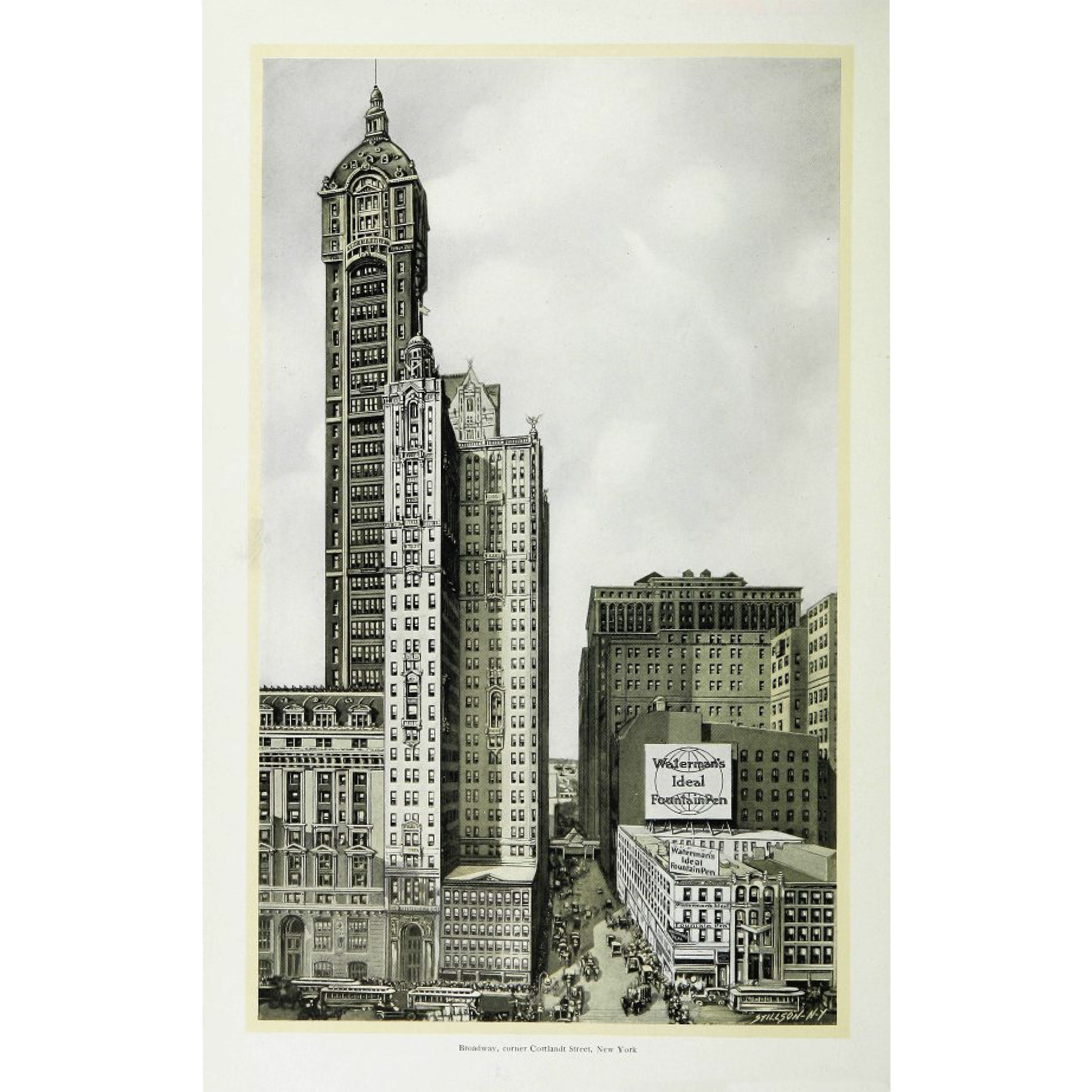 Image from the 1908 Waterman catalog showing the intersection of Broadway and Cortlandt Street
Image from the 1908 Waterman catalog showing the intersection of Broadway and Cortlandt Street
The brand was continued by Waterman and based on the 1918 Aikin Lambert catalog, may have at least initially operated as if it was a separate business as the Aikin-Lambert Company. At the time the business was moved to 10 Cortlandt Street, New York, about a block away and much closer to if not next door to L. E. Waterman at 173 Broadway. Maiden Lane changes to Cortlandt Street when crossing Broadway going west. Aikin Lambert eventually became a Waterman sub-brand (called an “affiliate” of the L. E. Waterman company in a 1937 brochure) and was evidently considered valuable enough for Waterman to continue it into the 1930s until at least 1937 with pens such as the SkyWriter and Vis-O-Pen.
A Jewel in the Hand
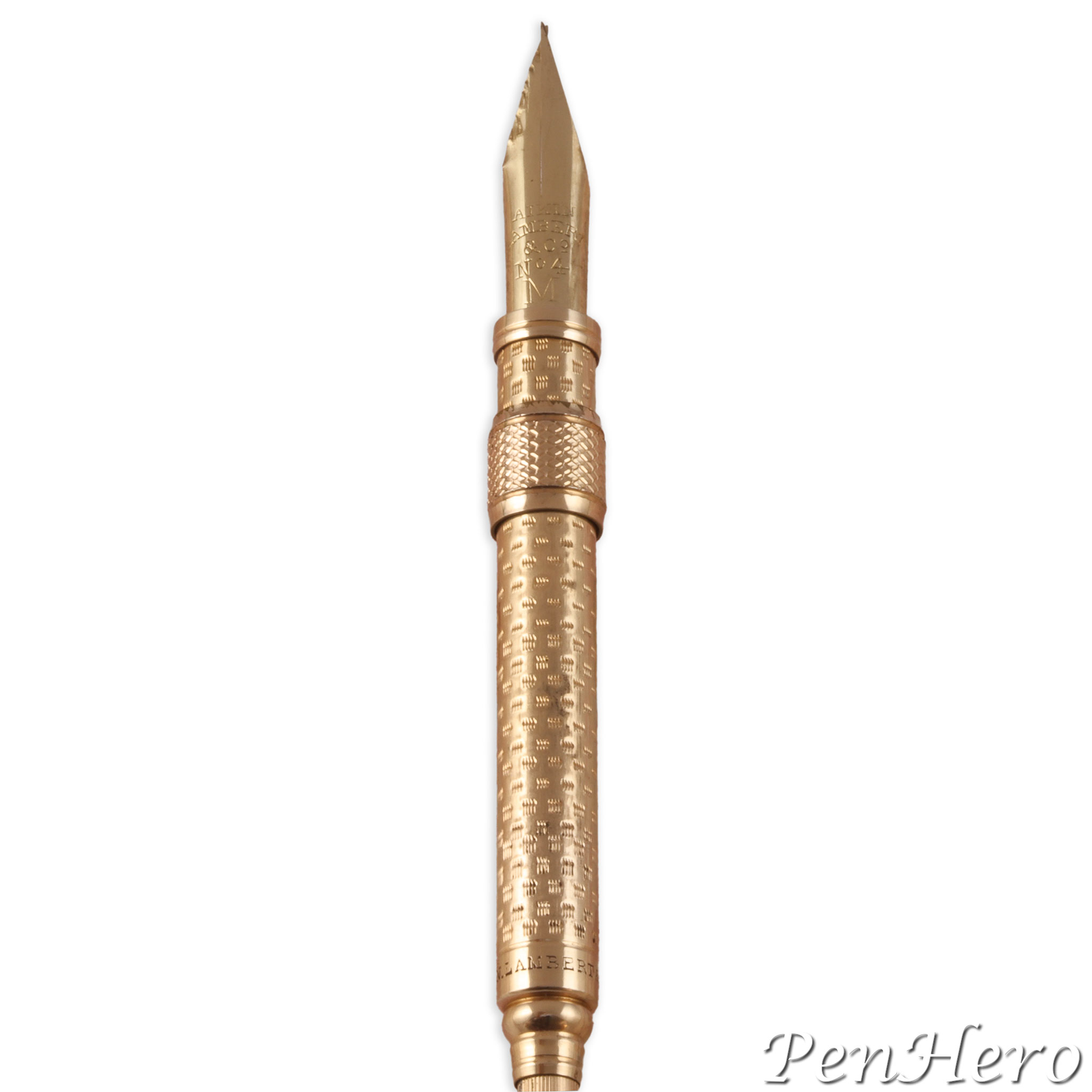 Aikin Lambert combination retracting pen holder and pencil c. 1880-90s, nib and barrel detail
Aikin Lambert combination retracting pen holder and pencil c. 1880-90s, nib and barrel detail
I can imagine this tiny 2 11/16 inch long writing instrument tucked into a vest pocket or ladies purse. The pencil easily extends and is usable by itself or turn it around and slide out the nib for a full 4 7/8 inch long pen. Unfortunately, the gold nib needed adjustment as the tines tended to overlap at the tip, but it did show a lot of flexibility and would likely be a nice writer once addressed. It’s possible the nib was a bit too large for the holder or was twisted at one point as one edge shows scuffing. Too bad, but again, this could be smoothed out by a nib smith.
The instrument came in the original box and was in surprisingly good condition. Many Victorian era pen holders and pencils show a lot of wear, no surprise as they are over a hundred years old, but this one is quite nice. Aikin Lambert was one of the top pen, pen holder, and pencil makers of the late nineteenth century and this example shows that quality. These are very collectible and difficult to find. I’ve seen impressive collections from this era at pen shows and the jewelry work on many examples is amazing. Don’t overlook these gems of the gilded age.
Acknowledgment
Thanks to David Nishimura for letting me know the pen holder described in United States Patent 243,319, dated June 21, 1881, was put into production. He has had several of them over the years. He let me know that most were made using braided metal cord rather than fusee chain. Both are vulnerable to the soldered attachments coming unstuck.
References
"7th Regiment, New York National Guard" © 2024 New York State Military Museum and Veterans Research Center
Advertisement, Chattanooga Daily Times, December 16, 1875, page 2
Advertisement, Chattanooga Daily Times, September 30, 1876, page 3
Advertisement, Chicago Tribune, October 17, 1871, page 4
Advertisement, Lexington Weekly Press, April 3, 1878, page 1
Advertisement, The American Stationer, July 5, 1883, page 26
Advertisement, The American Stationer, October 25, 1883, page 614
Advertisement, The American Stationer, March 12, 1891, page 580
Advertisement, The American Stationer, August 2, 1894, page 192
Advertisement, The American Stationer, October 9, 1915, page 35
Advertisement, The Book-Keeper, July 20, 1880, page 16
Advertisement, The Jeweler’s Circular and Horological Review, Volume 15, 1884, pages Lxvii and Lxxxvii
Advertisement, The Jeweler’s Circular, April 7, 1892, page 2
Advertisement, The Jeweler’s Circular and Horological Review, November 8, 1893, page 21
Advertisement, The Jeweler’s Circular, December 5, 1894, page 44
Advertisement, The Jeweler’s Circular-Weekly, May 13, 1908, page 29
Advertisement, The Jeweler’s Review, March 12, 1895, page 18
Advertisement, The Publisher’s Weekly, March 24, 1877, page 355
Advertisement, New England Stationer and Printer, October 1890 pages 30 and 38
Advertisement, Technique Advertiser, Published Annually by the Junior Class of the Massachusetts Institute of Technology, Volume 10, 1895, page 20
“Aikin, James Cornelius” The National Cyclopedia of American Biography, Volume XIV, James T. White and Company, New York, 1910, page 374
“Aikin, Lambert & Co., 1869 Aikin, Lambert Co. 1919” The Jeweler’s Circular-Weekly February 5, 1919, pages 177-178
Aikin Lambert Catalog, 1918
“Aikin, Lambert Change” The American Stationer, July 14, 1906, page 3
“Aikin Lambert history”, George Kovalenko, © The Writing Hand Press
"Amusements" The New York Times, January 22, 1882 page 11
“Death of Henry A. Lambert” The Jeweler’s Circular, May 21, 1919, page 93
“Figural novelty pencils, then and now”, by David Nishimura, October 27, 2013, © Vintage Pens LLC
Help Wanted Advertisement, “Wanted” The Sun May 2, 1866, page 3
Help Wanted Advertisement, “The Trades” New York Daily Herald October 23, 1864, page 3
“Henry A. Lambert, Member of Aiken (sic), Lambert & Co., is Dead” Geyer’s Stationer, May 29, 1919, page 72
“Henry A. Lambert Dies of Bronchial Pneumonia” The Keystone, June, 1919, page 188
“Henry A. Lambert” Office Appliances, July, 1919, page 155
“James C. Aikin” Geyer’s Stationer, May 16, 1901, page 8
“‘Mercantile’ Fountain Pen” The American Stationer September 20, 1894, page 524
“Obituary, Death of James C. Aikin” The Manufacturing Jeweler, Volume 48, Providence, RI, March 16, 1911, page 626
“Obituary, James C. Aikin” New York Tribune March 11 1911 Page 7
“Pens and Jewelry" Notable New Yorkers of 1896-1899, A Companion Volume to King's Handbook of New York City, by Moses King, 1899, Kings, page 528
“Splendid Gold Pens” The Marysville Appeal March 5, 1874, page 3
The Centennial Exposition, Described and Illustrated, Being a Concise and Graphic Description of this Grand Enterprise, Commemorative of the First Centenary of American Independence by J. S. Ingram, Hubbard Bros, Philadelphia, PA, 1876, Page 116
“The Funeral of J. C. Van (sic) Aikin" Poughkeepsie Eagle-News March 15, 1911, page 8
“The ‘Mercantile’ Fountain Pen” The American Stationer June 28, 1894, page 1222
“They Stole a Trunk” The Lebanon Daily News, Lebanon, PA, January 6, 1885, page 1
"United States Patent 243,319 Telescoping Holder for Pens" Official Gazette of the US Patent Office, June 21, 1881, page 1618
United States Trademark 472, Aikin, Lambert & Co., US Patent Office, October 17, 1871
United States Trademark 38,873 ALCo, Official Gazette of the US Patent Office, August 31, 1909, page 1240
“Waterman and Aikin Lambert”, by David Nishimura, December 13, 2012, © Vintage Pens LLC
Waterman Catalog, 1908
Waterman SkyWriter and Vis-O-Pen Brochure, dated September 1937
Interact
Comments on this article may be sent to the author, Jim Mamoulides

